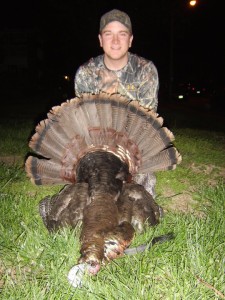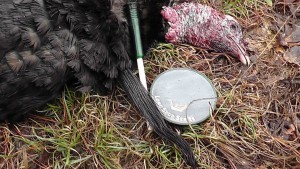Turkey Talk with Ryan Miloshewski

By Ryan Miloshewski
Ah, yes, it’s that time of year again. Easter lilies and red buds are blooming. You only need a light jacket in the morning. Crappie are starting to bite. Birds are singing their love songs as you awake for another day. And somewhere in the woods a turkey is gobbling. Spring is here, and for outdoorsmen this is more than welcome. Turkey season has started in Nebraska and most southern states. In Missouri, April 20th is a day we all have marked on our calendars. Much like the fall with my Whitetail Weekly segment, I am going to write a blog every week during turkey season with tips, tactics and facts about the birds we love to chase.
Missouri’s spring turkey season marks the end of a hunting drought for many across the state. Preparing gear, scouting, and honing of skills are the main tasks at hand until we can get out in the woods toting our trusty shotguns. I’ve compiled a list of turkey facts, hunting tips and ways to prepare and make this season your best yet!
Tactics
Right now, getting boots on the ground is your main approach. Get out in the woods early, in a spot where you won’t spook birds, and listen for gobbling. Take inventory of how many toms are sounding off, where they are located, and what time they fly down. During mid-morning or the afternoon take a walk to where you heard them earlier. See if you can pinpoint a major roost site, or where a group of toms was roosting. This will give you a good idea where they will be located once the season starts. In the evening, listen for turkeys flying up to the roost. Again, stay in an area where you won’t spook them and just listen. It’s a tease hearing and seeing turkeys, but it’ll help greatly once it’s time to get down to business. Like anything in life, adequate preparation makes the “game” much easier!

Random Thoughts
-Turkeys are breaking out of winter flocks. Toms are starting to roost alone or near hens. Much like bucks in the fall, they are now mortal enemies with their male counterparts. Strutting, gobbling and fighting are all starting to begin with purpose.
-A tom is generally 5-7 pounds heavier than hens. They have brighter, more iridescent feathers, larger head ornamentation (snood, wattles, dewlap) with varying colors to attract hens and prove their genetic worth. This is known as sexual dimorphism in a species.
-The beard of a turkey is made of modified feathers. The feathers keratinize and form the tassel-like object due to certain genetic differences in the make up of their cells.
-The arrector pili muscles are responsible for the raising of feathers when a tom goes into strut.
-Turkeys have white and dark meat. We all know that. But what’s the biological difference? White meat is made of, you guessed it, light muscle. These muscles are meant for short burst of energy and lack a lot of hemoglobin to sustain activity for too long. Dark meat is composed of dark muscle, which contains high levels of hemoglobin and can sustain a lot of activity for long periods of time. Turkeys walk more than they fly, so that is why the meat of the legs is dark and the breast is white.
-When a tom can see your decoys, refrain from calling. Let the decoys do their job and more times than not they will pull the gobbler into range.
-If you can hear hens with a gobbling tom, and they are not getting any closer, try challenging the hen/hens. Use excited cutts and yelps to get the boss hen excited. Mimic every call she makes, cut her off when she’s calling, and sound like an intruder hen. A lot of times this can bring in the entire group of turkeys, as the boss hen will come in to investigate, bringing the others in tow.
-A mature tom usually has 18 feathers in his tail fan.
-A turkey’s eyesight is second to none. If you can see a turkey, you can bet they can see you, too. Keep absolutely still and don’t raise your gun until their vision is obscured.
-Carry an array of turkey calls into the woods. You never know what sound will strike a tom’s fancy. Don’t be afraid to try your least favorite call if hunting gets tough. It might be just what the doctor ordered.
Quote of the week: “The first turkey that ever came to me on the ground did it a long time ago. I sat there with my hands shaking and my breath short and my heart hammering so hard I could not understand why he could not hear it. The last turkey that came to me last spring had exactly the same effect, and the day that this does not happen to me is the day that I quit.”—Tom Kelly
Links
-Support your local National Wild Turkey Federation chapter. Their commitment to sustaining turkey populations and habitat is vital to ensuring this sport we love continues to grow and remain a part of our lives. Visit their website at www.nwtf.org.
-Check out one of my favorite stories via Outdoor Life. It’s the story of Missouri’s own turkey hunting legend Ray Eye and his first bird: http://www.outdoorlife.com/photos/gallery/hunting/2009/01/boys-first-turkey
Happy hunting, scouting, and enduring this week! Turkey season will be here soon, and I, for one, cannot wait!
Ryan Miloshewski
Liked this story? Subscribe here for more updates!


